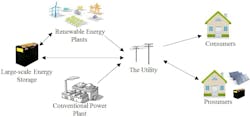A community microgrid, some prosumers and consumers — all with access to backup power from a utility — could form the basis for energy sharing in a community, according to a research report from a Missouri University of Science and Technology researcher.
Julia Morgan, a Ph.D student in systems engineering, has developed a model for energy sharing in a community. It would involve a microgrid, prosumers who use and sell renewable energy and storage, consumers, and a utility that provides backup. Her concept is explained in a research paper, “Energy Sharing Community as A Decentralized Complex Adaptive System of Systems.”
“The microgrid would be the network of prosumers and consumers. There would be no central plant, with the utility as backup,” she explains.
This type of energy sharing would yield environmental, cost, and reliability benefits, says Morgan.
Under Morgan’s model, each home in a community would have an energy management system, and the community members would be networked together with a more centralized energy management system. Prosumers would generate power with renewable resources and sell excess energy to other members of the community. Extra renewable energy could also go to the utility. And the utility could benefit by acquiring cheap prosumer power and possibly getting grid services from the microgrid, she says.
How energy sharing would work
“Say I have a solar panel and you don’t. You come to me and say, ‘On Monday I want to buy this much electricity from you at 4 pm. Or you could schedule the purchase in the home energy management system, buying this much electricity at this rate,” she says.
The energy management system at the user’s home would track the amount of supply available and demand in the community. Prosumers would be able to identify how much excess energy they have available at certain times of day. The prosumers’ energy would not be delivered via the utility, but through a decentralized system that allows energy to go directly to a consumer, she says.
Under her model, prosumers would set the price of electricity based on the utility’s prices, offering lower rates that change as often as hourly, Morgan says.
It’s important to have both consumers and prosumers present in this type of community because the consumers are the demand, she noted. At this point, however, her research has shown that there’s a bigger need for prosumers.
Utility as backup
“It would be a sharing community, decentralized, a microgrid, and the participants within the microgrid would be connected to each other. For backup they would be connected to the utility,” says Morgan. “There’s nothing like this out there.”
At some point, it’s possible that peer-to-peer energy trading could take place on the Missouri University of Science and Technology campus, where the university has three microgrids and a solar village with battery storage, she notes.
Examples of existing peer-to-peer energy sharing communities include the Brooklyn Microgrid.
The utility maintains the grid that delivers power, but energy is generated, stored and traded by members of the community using blockchain technology.
Another example is an EnSync Energy Systems project that involves a power purchase agreement between The Michaels Development Co. and EnSync in which the company will build a solar-plus-storage project at an affordable housing development in Hawaii. The plan is for residents to exchange energy directly with one another.
Energy sharing in Australia
And Origin Energy, an Australian power retailer, has launched an energy trading energy trading trial with Perth-based blockchain energy market provider, Power Ledger.
According to a statement from the two companies, the three-month technical trial, begun in October, will use “anonymised and historical” data from Origin customers to explore the benefits and challenges of peer-to-peer energy trading across the regulated network.
The trial is designed to prove the accuracy and security of an energy trading platform based on “cryptocurrency.”
Such efforts are all part of the “sharing economy,” says the Missouri University research paper, which points out that this trend has impacted the transportation and hospitality industries, with companies like Uber and Airbnb.
The paper notes that rapid deployment of renewable energy and storage has raised challenges for the utility industry, and that forming energy sharing communities locally could help address those challenges.
Redistribution of electricity
“An energy sharing community allows its participants to achieve a greater outcome than they would individually. Participants who generate excess electricity are able to share their generation with participants of their choosing. They are also able to take advantage of shared energy storage systems in the community to improve operational reliability and economy,” says the research paper.
The sharing economy also allows energy consumers to choose who they can purchase electricity from. “This gives consumers a flexibility in managing their consumption,” says the research paper.
“Ultimately our solution is the redistribution of electricity through energy sharing,” says Morgan.
Track news about energy sharing. Subscribe to the free Microgrid Knowledge newsletter.








